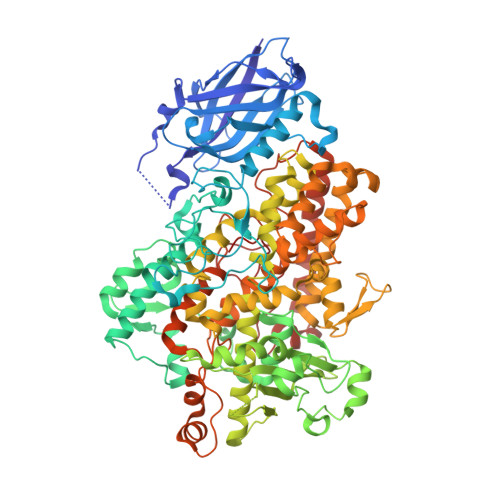Hydrogen-Deuterium Exchange of Lipoxygenase Uncovers a Relationship between Distal, Solvent Exposed Protein Motions and the Thermal Activation Barrier for Catalytic Proton-Coupled Electron Tunneling.
Offenbacher, A.R., Hu, S., Poss, E.M., Carr, C.A.M., Scouras, A.D., Prigozhin, D.M., Iavarone, A.T., Palla, A., Alber, T., Fraser, J.S., Klinman, J.P.(2017) ACS Cent Sci 3: 570-579
- PubMed: 28691068
- DOI: https://doi.org/10.1021/acscentsci.7b00142
- Primary Citation of Related Structures:
5T5V, 5TQP - PubMed Abstract:
Defining specific pathways for efficient heat transfer from protein-solvent interfaces to their active sites represents one of the compelling and timely challenges in our quest for a physical description of the origins of enzyme catalysis. Enzymatic hydrogen tunneling reactions constitute excellent systems in which to validate experimental approaches to this important question, given the inherent temperature independence of quantum mechanical wave function overlap. Herein, we present the application of hydrogen-deuterium exchange coupled to mass spectrometry toward the spatial resolution of protein motions that can be related to an enzyme's catalytic parameters. Employing the proton-coupled electron transfer reaction of soybean lipoxygenase as proof of principle, we first corroborate the impact of active site mutations on increased local flexibility and, second, uncover a solvent-exposed loop, 15-34 Å from the reactive ferric center whose temperature-dependent motions are demonstrated to mirror the enthalpic barrier for catalytic C-H bond cleavage. A network that connects this surface loop to the active site is structurally identified and supported by changes in kinetic parameters that result from site-specific mutations.
Organizational Affiliation:
Department of Chemistry, University of California, Berkeley, California 94720, United States.















